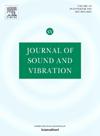距离相关环境下水下声学抛物方程的Galerkin谱元方法
IF 4.9
2区 工程技术
Q1 ACOUSTICS
引用次数: 0
摘要
准确的声传播建模对海洋探测和通信中的水声学研究至关重要。经典的广角抛物方程模型通常采用低阶有限差分或有限元格式离散,在精度和效率方面存在局限性。虽然基于chebyhev - tau谱方法的SMPE提高了精度,但它在正推过程中需要恒定的层厚度,因此不适合用于距离相关的海底问题。为了解决这些限制,我们提出了一种Galerkin谱元方法来求解分步帕德瓦节能抛物方程。该方法放宽了解的正则性要求,增强了复杂边界条件的处理能力,生成了对称的块对角矩阵系统,提高了计算效率。数值实验证明了该方法的准确性和性能,特别是在楔形海洋的上坡传播模拟中,该方法以更少的深度插值点和更大的距离步长获得了高质量的结果。该方法为基于距离的水声建模提供了一种鲁棒且高效的解决方案。本文章由计算机程序翻译,如有差异,请以英文原文为准。

Galerkin spectral-element methods for parabolic equations in underwater acoustics with range-dependent environments
Accurate modeling of sound propagation is vital for underwater acoustics in ocean exploration and communication. Classical wide-angle parabolic equation models, often discretized using low-order finite difference or finite element schemes, face limitations in accuracy and efficiency. While the Chebyshev-Tau spectral method based SMPE improves accuracy, it requires constant layer thickness during forward stepping, making it unsuitable for range-dependent seafloor problems. To address these limitations, we propose a Galerkin spectral-element methods for solving split-step Padé energy-conserving parabolic equations. Our method relaxes the regularity requirements of solutions, enhances complex boundary condition handling, and generates a symmetric, block-diagonal matrix system, improving computational efficiency. Numerical experiments demonstrate the method’s accuracy and performance, particularly in up-slope propagation simulations in wedge-shaped oceans, where it achieves high-quality results with fewer depth interpolation points and larger range-step sizes. This approach offers a robust and efficient solution for range-dependent underwater acoustic modeling.
求助全文
通过发布文献求助,成功后即可免费获取论文全文。
去求助
来源期刊

Journal of Sound and Vibration
工程技术-工程:机械
CiteScore
9.10
自引率
10.60%
发文量
551
审稿时长
69 days
期刊介绍:
The Journal of Sound and Vibration (JSV) is an independent journal devoted to the prompt publication of original papers, both theoretical and experimental, that provide new information on any aspect of sound or vibration. There is an emphasis on fundamental work that has potential for practical application.
JSV was founded and operates on the premise that the subject of sound and vibration requires a journal that publishes papers of a high technical standard across the various subdisciplines, thus facilitating awareness of techniques and discoveries in one area that may be applicable in others.
 求助内容:
求助内容: 应助结果提醒方式:
应助结果提醒方式:


